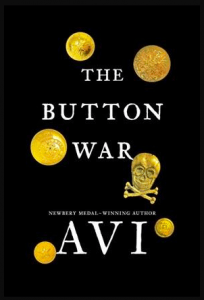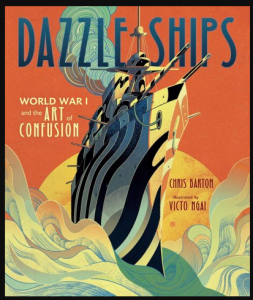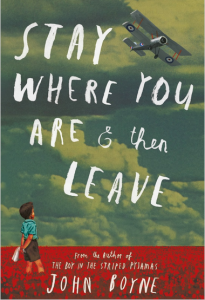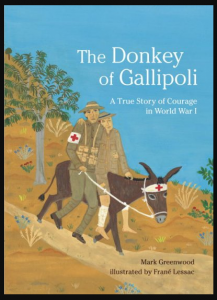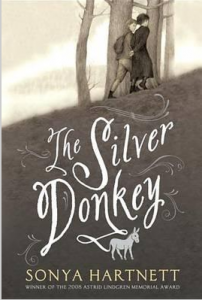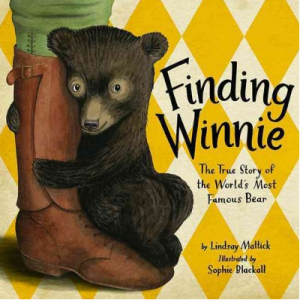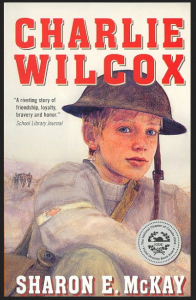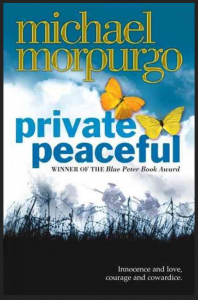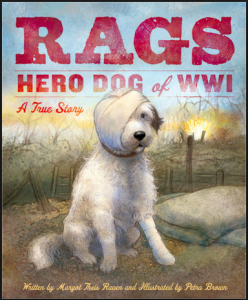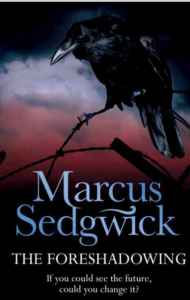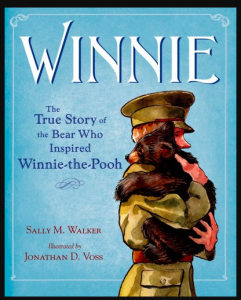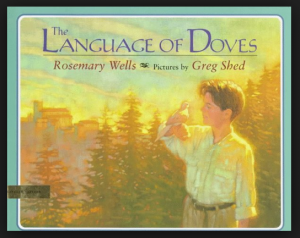Stories of World War I
Avi. The Button War. Somerville, Massachusetts. Candlewick Press, 2018.
Anything written by Avi is worth reading. Anything published by Candlewick is worth considering. And this World War I story is absolutely riveting: the animosities among a group of boys in Russian-occupied Poland during the summer of 1914 are revealed by a competition to collect military buttons. This intense 229-page novel is not for readers looking for a light-hearted read but rather for thoughtful readers – 11-years-old and up – who understand how fierce rivalry can lead to betrayal and violence. [Bullying; Competition; Poland; World War, 1914-1918)
Barton, Chris. Dazzle Ships: World War I and the Art of Confusion. Minnneapolis: Millbrook Press, 2017.
Why paint ships in eye-catching patterns? Why use striking colours? To confuse the enemy. German submarines were attacking British ships during the first World War. Not only warships but also ships bringing food to the island nation. A quiet unassuming lieutenant-commander came up with an idea: paint ships in bold colours and patterns that make it difficult to discern the speed and direction of travel. The German torpedoes would be less likely to hit the British ships. In 1917, the project began and by the end of the war in 1918, almost 3,000 British ships and over 1200 American ships had been painted in dazzling designs.
This fascinating nonfiction picture book – illustrated by award-winning Victo Ngai – is beautifully designed. The style and size of the font complements the tone of the story and the brilliance of the artwork. Additional information – including a timeline and bibliography – is included at the end of the book. The rhythm of the story makes it wonderful for reading aloud but this children’s book is highly recommended for readers of any age interested in art and the history of war.
Boyne, John. Stay Where You Are & Then Leave. Toronto: Doubleday Canada, 2014.
After his father has been away at war for four years, Alfie discovers his father is not on a secret mission at all but is instead a patient at a nearby hospital. Another highly recommended novel by an author who specializes in showing life from unusual perspectives.
Eldridge, Jim. The Trenches. New York: Scholastic, 2002.
The Trenches … tells story of courage, fearlessness and bravery. Set in Passchendale between 1914 and 1918, it describes the experiences of a bold Billy Stevens who decides to join Word War One as a communications officer. This story kept me entertained on every page. I was excited to see what was going to happen next. It entertained me with its intriguing story line that made me want to turn every page. It informed me about the horrific pictures of war and the things that made it that way. It also informed me more about what people decide to do in the war. During one part, the Germans and Americans exchanged gifts with one another. No gunshots were fired that day. It really made me feel that war is not all violence, blood and killing. Most importantly, the book has changed how I see the world. What would the world have been like if Germany had won the war? How would our lives be different today if that happened? If you like books that bring bravery, courage and fearlessness to you, you will love this story. (Carter in grade eight)
…
Foreman, Michael. War Game: Village Green to No-Man’s Land. London: Pavilion Books, 1993.
An award-winning picture book about four English soldiers who play football with German soldiers during the Christmas truce of 1914. The main characters are based on the author’s uncles who were in killed in the war. Highly recommended for readers 6-years-old and up.
…
Granfield, Linda. In Flanders Fields: The Story of the Poem by John McCrae. Toronto: Lester Publishing, 1995.
Greenwood, Mark. The Donkey of Gallipoli: a True Story of Courage in World War I. Cambridge, Mass.: Candlewick Press, 2008.
Jack grew up dreaming of adventure. When he grew up, he did have an adventure: he travelled from England to Australia. But then the war started. He was sent to Egypt and then to Turkey where he helped take injured soldiers off the battlefields with the help of a donkey he named Duffy. He bravely kept rescuing soldiers until he was eventually shot and killed by a sniper. This picture book biography, illustrated by Frané Lessac, is recommended for readers and listeners 7 years old and up. [Courage; Donkeys; Kirkpatrick, John Simpson; Soldiers; Turkey; WW1]
Hartnett, Sonya. The Silver Donkey. Somerville, MA: Candlewick Press, 2004.
“In France during World War I, four French children learn about honesty, loyalty, and courage from an English army deserter who tells them a series of stories related to his small, silver donkey charm.” – CIP
Hesse, Karen. The Brightwood Code. New York: Little, Brown and Company, 2024.
Eighteen-year-old Edda has returned from France, where she served as a telephone operator on the front lines of World War 1. Now at home in America, she is still working as a telephone operator, but her life has not become peaceful. Traumatic memories haunt her and mysterious phone calls terrify her. What actually happened in France and who is trying to harm her? Slowly, the truth is revealed. A story of courage and determination, this outstanding 317-page novel is highly recommended for mature readers fourteen years old and up.
“It’s not that grief gets smaller, it’s that life gets bigger around it.”
(Note: due to the sexual references, some parents and private schools may prefer to reserve this book for older readers.)
Mattick, Lindsay. Finding Winnie: the True Story of the World’s Most Famous Bear. Toronto: HarperCollins Publishers Ltd, 2015.
“During World War I, Captain Harry Colebourn, a Canadian veterinarian rescued a bear cub on his way to Europe and took her to the war.” – CIP. Written by the great-granddaughter of Harry Colebourn, beautfully illustrated by Sophie Blackall, and accompanied by historical photographs, this thoughtful informative book is highly recommended for readers 8-years-old and up.
“‘Sometimes,’ I said, ‘you have to let one story end so the next one can begin.’
“‘How do you know when that will happen?’
“‘You don’t,’ I said. ‘Which is why you should always carry on.'”
…
McKay, Sharon E. Charlie Wilcox. Toronto : Penguin Canada, 2003.
McKay, Sharon E. Charlie Wilcox’s Great War. Toronto : Penguin Canada, 2003.
…
Morpurgo, Michael. Private Peaceful. London: Collins, 2004, c2003.
“When ThomasPeaceful’s older brother is forced to join the British Army, Thomas decides to sign up as well, although he is only fourteen years old, to prove himself to his country, his family, his childhood love, Molly, and himself.” – CIP
…
Morpurgo, Michael. War Horse. New York : Scholastic, 2007, c1982.
“Joey the horse recalls his experiences growing up on an English farm, his struggle for survival as a cavalry horse during World War I, and his reunion with his beloved master.” – CIP Recommended for readers ten to fourteen-years-old.
…
Murphy, Jim. Truce: the Day the Soldiers Stopped Fighting. New York : Scholastic Press, 2009.
A nonfiction account of the 1914 Christmas Day truce.
Raven, Margot Theis. Rags: Hero Dog of WWI: A True Story. Ann Arbor, MI: Sleeping Bear Press, 2014.
“A stray dog named Rags befriends a U.S. soldier in Paris, France during WWI. Rags traveled with the troops carrying messages from the front line to the back. His loyalty kept him by his owner’s side until Sergeant Donovan died at the base hospital in Chicago.” – CIP A nonfiction picture book for dog lovers 8-years-old and up.
Sedgwick, Marcus. The Foreshadowing. London: Orion Children’s Books, 2006, c2005.
“Having always been able to know when someone is going to die, Alexandra poses as a nurse to go to France during World War I to locate her brother and to try to save him from the fate she has foreseen for him.” – CIP. Recommended for competent readers 12 years old and up. [England; Extrasensory perception; France; Individuality; Nurses; Sex role]
…
Walker, Sally M. Winnie: The True Story of the Bear Who Inspired Winnie-the-Pooh. New York: Henry Holt and Company, 2015.
Winnie-the-Pooh is a lovable bear who lives with his friends in the Hundred Acre Wood. At least in the stories. But who was the real Winnie?
This biography tells the story. Harry Colebourn, a Canadian veterinarian, adopted a bear cub which he took along when he was shipped overseas during World War I. Winnie became the regiment’s mascot, named after its hometown of Winnipeg, Manitoba. But when the soldiers were sent over to France, Winnie couldn’t go along. This picture book tells the story of what happened to the little bear and how it came to be known around the world.
Illustrated in pen and ink and watercolour by Jonathan D. Voss and accompanied by black and white photographs, this gentle book is recommended for all readers fond of the honey-loving ‘Bear of Very Little Brain.’
Wells, Rosemary. The Language of Doves. New York : Dial Books for Young Readers, c1996.
“On her sixth birthday Julietta’s grandfather gives her one of his beautiful homing pigeons and tells her a story of his experience raising and training doves in Italy during the Great War.” – CIP Highly recommended as a read-aloud for ages eight to ten.
